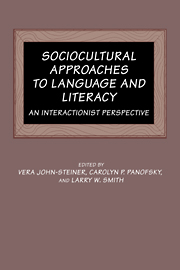Book contents
- Frontmatter
- Contents
- List of contributors
- 1 Introduction
- Part 1 Context
- Part II Mediational processes
- 5 Nonverbal factors in the interpsychic to intrapsychic internalization of objects
- 6 An ecological approach to the emergence of the lexicon: Socializing attention
- 7 Learning how to explain: The effects of mother's language on the child
- 8 Developing the representational functions of language: The role of parent–child book-reading activity
- 9 The implications of Vygotskian theory for the development of home-school programs: A focus on storybook reading
- 10 Vygotsky in the classroom: An interactionist literacy framework in mathematics
- Part III Functional systems
- Author index
- Subject index
10 - Vygotsky in the classroom: An interactionist literacy framework in mathematics
Published online by Cambridge University Press: 05 November 2011
- Frontmatter
- Contents
- List of contributors
- 1 Introduction
- Part 1 Context
- Part II Mediational processes
- 5 Nonverbal factors in the interpsychic to intrapsychic internalization of objects
- 6 An ecological approach to the emergence of the lexicon: Socializing attention
- 7 Learning how to explain: The effects of mother's language on the child
- 8 Developing the representational functions of language: The role of parent–child book-reading activity
- 9 The implications of Vygotskian theory for the development of home-school programs: A focus on storybook reading
- 10 Vygotsky in the classroom: An interactionist literacy framework in mathematics
- Part III Functional systems
- Author index
- Subject index
Summary
This is an account of what happened in one elementary school classroom when teacher and students dwelt for a while in what Newman, Griffin, and Cole (1989) call the “construction zone,” a realm of socially mediated interactions and Vygotsky's zone of proximal development. The domain was literate exploration of a broad mathematical concept, group theory, a view and a topic usually unavailable to American sixth graders.
My goals (I was at that time the classroom teacher) were to give young students an opportunity “to do what mathematicians do,” to explore and make connections between seemingly disparate realms, to construct mutually a literate understanding of a mathematical principle, to participate in a process of concept formation, and to have time to experience cognitive change. I hoped to develop a mathematically rich context, broad enough to encourage
the “construction zone,” a magic place where minds meet, where things are not the same to all who see them, where meanings are fluid, and where one person's construal may preempt another's.
(White, 1989, p. ix)The instructional methodology was an interactionist literacy framework. I was concerned with maintaining a rich classroom climate that would facilitate three of Vygotsky's findings: first, cognitive change proceeds from interpsychological to intrapsychological; second, school learning introduces the zone of proximal development, which “characterizes mental development prospectively” (Vygotsky, 1978, p. 78); and third, “the development of the child's spontaneous concepts proceeds upward, and the development of his scientific concepts downward” (Vygotsky, 1962, p. 108).
Information
- Type
- Chapter
- Information
- Sociocultural Approaches to Language and LiteracyAn Interactionist Perspective, pp. 265 - 298Publisher: Cambridge University PressPrint publication year: 1994
